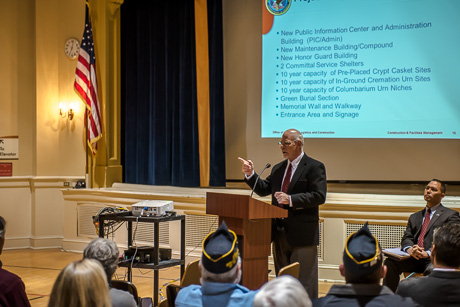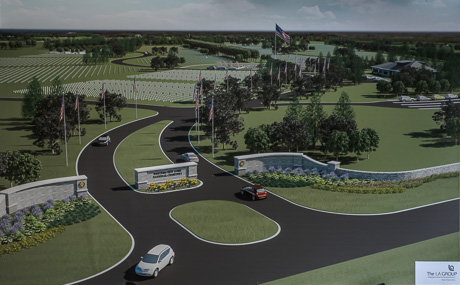
The first deceased veteran could be buried in the planned new veterans cemetery in Pembroke within three years, according to VA officials who presented information on the project at a meeting Thursday night at the VA Hospital in Batavia.
The VA's National Cemetery Administration is completing the planning process now, then an architect will complete the site design, which will enable the creation of construction documents so the project can go out to bid.
Before bidding can open, Congress will need to authorize spending for construction.
Spending approval is likely to be not much more than a formality, said Glenn Madderom, with the cemetery administration. The project has the support of New York's congressional delegation, so it should be included in the 2017 budget that Congress begins working on in October.
Madderom shared the preliminary site design, which included an outline of an area to be constructed first so that that section could be opened for burials within 18 months of the start of construction.
The drawings shared with the audience of about 100 people, mostly veterans, included the entryway, flag assembly area, public information building, maintenance building, committal shelter and columbarium.
The cemetery has yet to be named. Local veterans are invited to submit name suggestions and one of the criteria for the name is that it have the broad support of area veterans.
It must also be a geographic name that will help anybody in the nation locate the cemetery. It can't be named after a person or other non-geographic identifier. It should have a positive connection to the history of the region.
Local funeral director Ron Konieczny, a veteran active in the American Legion, said that several families whose veteran loved ones have died have had their remains cremated and the urns are stored at Konieczny's funeral home awaiting internment in the new cemetery. What Konieczny wanted to know is, what about families whose loved ones were buried in private cemeteries, could those remains be transferred to the veterans cemetery?
The answer is yes, but the family must pay for the disinterment and transportation to the cemetery. Once the remains arrive at the gates of the national cemetery, the cemetery administration takes over.
There is no cost for any veteran or veteran's spouse and qualifying children to be buried in a national cemetery. The service, casket or urn, burial plot and burial service are all provided at no cost to the family.
Typically, Madderom said, when a new cemetery opens, there are the remains of 100 to 150 veterans waiting to be interred.
Questions about this service included whether married veterans each get their own plot and what about the veteran with multiple spouses.
In cases where both people in a marriage are veterans, both are eligible for their own plot or urn niche, or they could share, if they request that arrangement.
In the case where a spouse dies and both are veterans and they want to be buried next to each other, a neighboring plot is kept vacant. Otherwise, plots are assigned on a first come, first-served basis. There are no plot reservations (say, a request to be buried under a tree or a location with a view) in a national cemetery.
Which raised the question, about the veteran who remarries?
Multiple spouses can be accommodated, said Jim Metcalfe, who will be director of the new cemetery.
"Yes we do have some veterans out there who do have three spouses buried with them," he said.
Other questions dealt with construction materials and vegetation.
Headstones are all uniform and made of white marble, which can only be obtained in Vermont and Georgia.
Architect Joseph G. Sporko, from the LA Group in Saratoga Springs, said he is looking at locally quarried limestone and bluestone for design elements, such as the entryway, in the cemetery. Native species for trees and plants will be given first consideration for inclusion in the landscape, but the plants must also be functional, such as providing appropriate windscreens.
An audience member asked about using Medina sandstone, but Sporko said there are no longer any sources available for Medina sandstone. A contractor in the audience who deals with stonework agreed with that assessment.
Mark Tillotson, from the VA's Office of Construction and Facilities Management, encouraged anybody who hasn't been to a national cemetery to do so. He said the VA takes a great deal of care in the design and care of veterans cemeteries. People who do visit are easily convinced their veteran loved ones should be lain to rest in such a beautiful setting.
"Once somebody sees a national cemetery, it's really a moving experience," he said.
Top photo: Glenn Madderom. Second photo: Mark Tillotson speaking.



